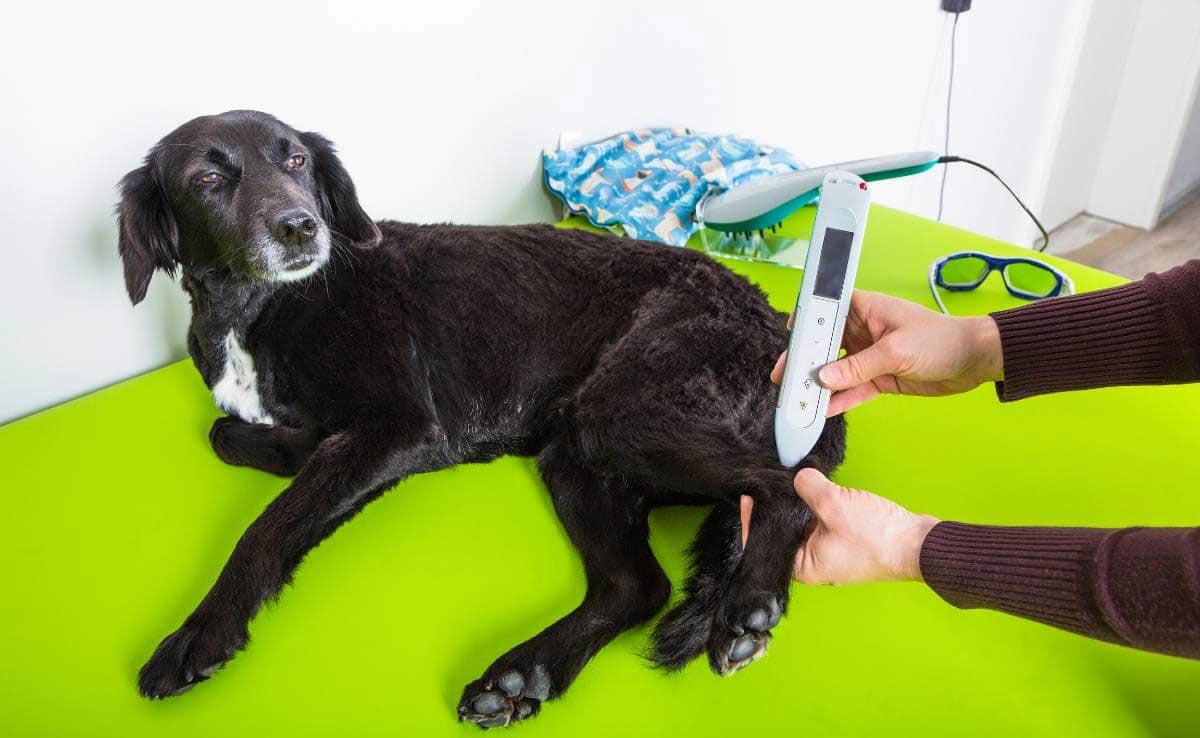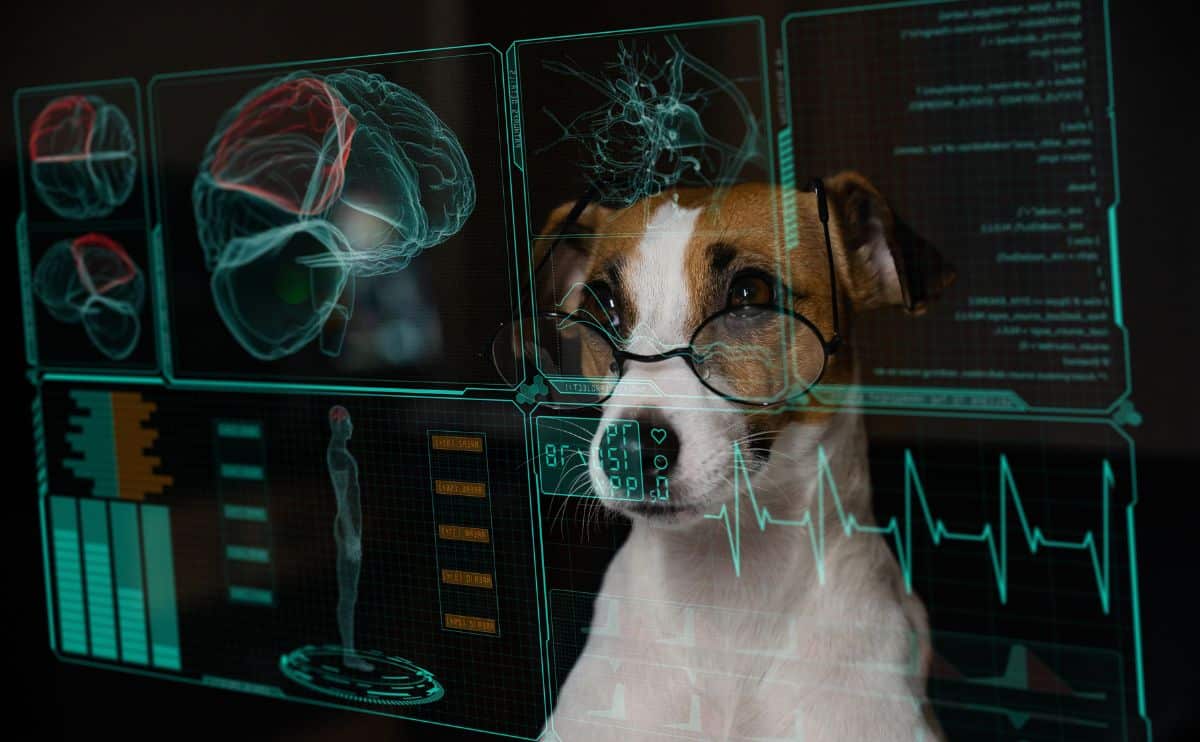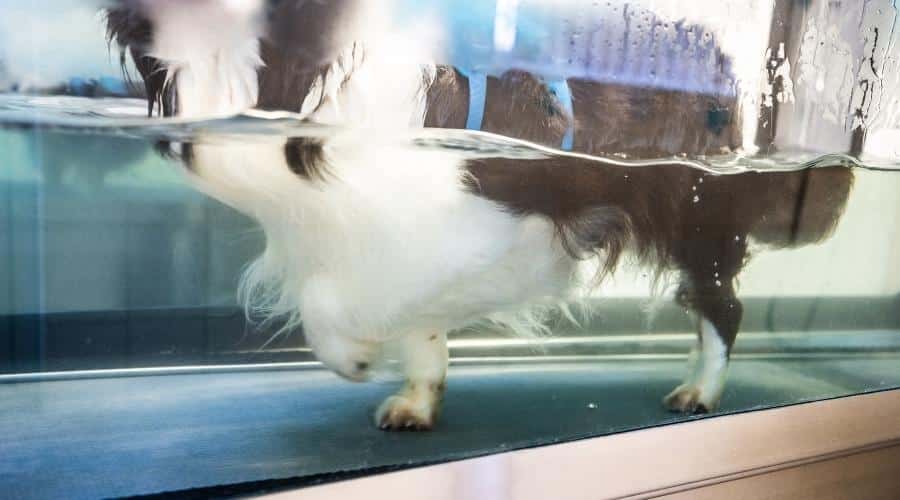Laser Therapy for Dogs Explained: Drug-Free Pain Relief for Dogs
When you purchase through links on our site, we may earn a commission. Here’s how it works.
If your once-energetic pup has slowed down—limping, stiff joints, or just not as playful as they used to be—you’re not alone. Aging, arthritis, and injuries can put a red light on your dog’s movement. But what if there was a way to give them the green light to run, jump, and play again?
Table of Contents

Enter laser therapy—a game-changing, non-invasive treatment that’s helping dogs heal faster, reduce pain, and get their zoomies back without pills or surgery. This high-tech wellness hack is already making waves in human medicine. Now, veterinarians are using it to help dogs recover from injuries, manage chronic conditions, and even bounce back from surgery.
Here’s what you need to know about how laser therapy works, the conditions it treats, and why more pet owners are turning to this innovative approach for their dogs’ health.
What Is Laser Therapy For Dogs?
Suppose your dog is slowing down, struggling with stiff joints, or recovering from an injury. You’re likely looking for effective ways to help them feel better without relying on endless medications or invasive treatments. Laser therapy offers a solution.
This non-invasive treatment uses specific wavelengths of light to stimulate healing, reduce inflammation, and relieve pain.
Light therapy has been used for years in anti-aging treatments, skincare, detoxification, pain management, and muscle recovery. Given its success in human health, it’s no surprise that veterinarians now use light therapy to help dogs recover from injuries, manage chronic conditions, and improve mobility.
Unlike surgical lasers that cut tissue, these lasers work at a lower intensity, penetrating deep into cells to accelerate natural healing processes. This makes it an appealing option for pet owners looking for drug-free pain relief and faster recovery times for their dogs.
How Does Light Therapy Work?
Light therapy, also known as photobiomodulation, is an umbrella term for treatments that use specific wavelengths of light to stimulate healing. This category includes laser therapy, infrared light therapy, and LED (Light Emitting Diode) therapy. While the light sources differ in intensity and penetration depth, all forms aim to reduce inflammation, improve circulation, and accelerate tissue repair.
The key to its effectiveness is how light interacts with the body’s cells. Targeted wavelengths penetrate the skin and underlying tissues, stimulating mitochondria—the powerhouse of cells—to produce more adenosine triphosphate (ATP), the energy source that fuels cellular repair and regeneration (i.e., boosting cellular energy to speed up healing). This process helps accelerate recovery and reduce discomfort.
Additionally, light therapy triggers the release of nitric oxide, which dilates blood vessels, improving circulation and oxygen delivery to damaged tissues. These biological responses contribute to reduced pain, enhanced healing, and improved mobility in dogs undergoing laser therapy.
Types of Light Therapy: What’s the Difference?
Not all light therapy is the same. Different wavelengths of light penetrate to various depths and trigger varying biological responses. Understanding these distinctions is key to choosing the most effective treatment for a condition.
Red Light Therapy & Near-Infrared Light Therapy
Both red and near-infrared (NIR) light are used in therapeutic applications, but they target different layers of tissue:
- Red Light (620-750 nm): This visible light penetrates the surface layers of the skin and is effective for treating wounds, inflammation, skin health, circulation, and superficial pain relief. Think of red light as a gentle sunbeam on your skin, providing warmth and surface-level benefits.
- Near-Infrared Light (750-1200 nm): Invisible to the human eye, NIR light reaches deeper into muscles, joints, and nerves, making it ideal for pain management, muscle recovery, joint health, inflammation reduction, and nerve regeneration. It’s like warmth soaking into your muscles after sitting in the sun for a while.
| Wavelength (nm) | Depth of Penetration | Common Uses |
|---|---|---|
| 620-750 nm (Red Light) | Superficial (skin, soft tissue) | Minor wound healing, inflammation reduction, circulation, skin care |
| 750-1200 nm (NIR Light) | Deep (muscles, joints, nerves) | Pain management, inflammation reduction, tissue repair, nerve regeneration, stress reduction |
Low-Level Laser Therapy (LLLT) & Cold Laser Therapy
These two forms of laser therapy are often used interchangeably, but they share distinct characteristics:
- Low-Level Laser Therapy (LLLT): Uses red or NIR light to stimulate cellular function without generating high heat. It is used for pain relief, inflammation reduction, and tissue repair.
- Cold Laser Therapy: A subset of LLLT, cold laser therapy utilizes longer, low-energy wavelengths that do not produce heat, making it safe for chronic pain management and surface-level skin issues, like minor wounds and hot spots.
Most therapeutic lasers emit red and near-infrared wavelengths, allowing for surface-level and deep-tissue treatment.
Laser therapy devices are also classified by power output. Depending on their intensity, cold lasers and LLLT can fall under either Class 3 or Class 4. Increased power allows clinicians to treat larger areas faster, but it may also increase the risk of thermal damage, which is why Class 4 lasers are typically limited to clinical use.
How to Compare At-Home Laser Devices
When comparing at-home laser therapy devices, you’ll notice differences in terms like wavelength, power output, and number of diodes. Here’s what those mean and why they matter:
- Wavelength (measured in nanometers or nm) determines how deeply the light can penetrate. Red light (around 650nm) is best for surface-level issues, while near-infrared (around 850nm) reaches deeper tissues like muscles and joints.
- Power Output (measured in milliwatts or mW) impacts the intensity and efficiency of treatment. Higher-powered lasers can treat deeper tissues more quickly, but lower-powered lasers may be safer and sufficient for surface-level care.
- Diodes are the individual light sources built into the device. Devices with more diodes spread light over a wider area—ideal for large joints or backs. Devices with fewer, higher-powered diodes offer focused, deep-penetrating treatment for targeted relief.
More diodes doesn’t always mean better—it depends on your dog’s needs. For example, a belt-style device with many diodes may be great for hip dysplasia, while a handheld laser with fewer, stronger diodes may be more effective for pinpointing areas like the knee or shoulder.
Choosing The Right Therapy For Your Dog
The type of light therapy best suited for a dog depends on the condition being treated. Red light therapy is beneficial for superficial wounds and inflammation, whereas near-infrared and laser therapy are more effective for deep muscle and joint issues. Veterinarians tailor treatment plans based on the dog’s specific needs, ensuring optimal healing outcomes.
Is Laser Therapy Backed By Science?
Yes, a wealth of scientific research supports the effectiveness of laser therapy. Studies have demonstrated its effectiveness in reducing pain, decreasing inflammation, and accelerating tissue healing in both humans and animals.

Veterinary studies have confirmed the benefits of laser therapy for conditions like osteoarthritis, wound healing, and post-surgical recovery. While results can vary based on factors like wavelength, dosage, and treatment duration, the overall consensus is that properly applied laser therapy is a safe and effective tool in veterinary medicine.
Conditions Treated By Laser Therapy
Laser therapy treats various conditions in dogs, particularly those related to pain, inflammation, and tissue healing. Common applications include:
- Arthritis & joint pain – Helps reduce inflammation and improve mobility in dogs with osteoarthritis and degenerative joint disease.
- Ear infections – Helps with chronic ear infections by reducing inflammation and promoting circulation.
- Hip dysplasia – Provides pain relief and supports joint function for dogs with hip dysplasia.
- Intervertebral disc disease (IVDD) – Aids in reducing inflammation and promoting nerve healing in spinal injuries.
- Lick granulomas & hot spots – Aids in healing persistent skin irritations and reducing inflammation.
- Neurological conditions – Supports nerve regeneration in cases of paralysis or nerve damage.
- Post-surgical recovery – Reduces swelling and pain while promoting tissue regeneration after surgery.
- Soft tissue injuries – Speeds healing for sprains, strains, and ligament injuries.
- Wound healing – Enhances recovery from surgical incisions, cuts, and abrasions.
Laser Treatment For Arthritis In Dogs
Research has demonstrated the effectiveness of laser therapy in improving mobility and reducing discomfort in dogs with osteoarthritis.
A Veterinary Medicine and Science study observed that dogs treated with low-level laser therapy exhibited increased daily activity and step counts shortly after beginning treatment, indicating enhanced mobility.
Another randomized, double-blinded, controlled trial reported that photobiomodulation therapy significantly reduced pain levels and improved clinical outcomes in dogs with moderate to severe hip osteoarthritis.
Additionally, a preliminary clinical study noted that laser therapy improved the quality of life for dogs with osteoarthritis, as perceived by their owners, and decreased the need for systemic analgesics. Importantly, no side effects were observed during the study.
Comparison With Other Arthritis Treatments
Laser therapy presents a drug-free alternative to traditional arthritis treatments such as nonsteroidal anti-inflammatory drugs (NSAIDs). Unlike NSAIDs, which can have gastrointestinal or kidney-related side effects, laser therapy has been shown to reduce pain and inflammation without adverse effects.
Furthermore, laser therapy can complement other treatment modalities, including joint supplements and physical therapy, providing a comprehensive approach to managing canine arthritis.
How Is Laser Therapy Performed In Dogs?
Laser therapy is a low-stress, non-invasive procedure that a veterinarian or a trained professional typically performs in a veterinary clinic. The process is generally quick, comfortable, and painless for your dog. Here’s what to expect when getting laser therapy through your vet:

Initial Consultation
Before starting laser therapy, the veterinarian will perform a thorough examination to assess your dog’s condition and determine if laser therapy is the right treatment option. They will also create a customized treatment plan based on your dog’s needs.
Placement & Positioning
During the treatment, your dog will be awake and typically lie down or sit. Sedation or restraint is rarely necessary, as most dogs find the experience pleasant and may even relax or sleep during the procedure. Depending on the area being treated, your dog may wear protective goggles, or an assistant may help direct their eyes away from the laser beam to ensure safety.
Laser Application
A handheld laser wand is gently moved back and forth over the treatment area, producing a slightly warming sensation on your dog’s fur. The light from the laser penetrates the skin and stimulates cellular activity to promote healing, reduce inflammation, and alleviate pain. During the session, your dog may feel mild warmth or tingling, but no pain is involved.
Session Duration
Each laser therapy session typically lasts up to 30 minutes, depending on the size of the area being treated and the severity of your dog’s condition. Smaller treatment areas require less time, while larger or deeper areas may take longer.
Number Of Sessions
The number and frequency of treatments will vary based on the injury and laser type. Your dog may initially need 2–3 sessions a week for acute conditions or injuries, with fewer sessions as improvement is seen.
Chronic conditions, such as arthritis, may require ongoing maintenance sessions, usually once every 2–4 weeks. Some dogs show significant improvement after just one or two sessions, while others may need multiple sessions before noticeable results are observed.
Post-Treatment Care
No recovery time is needed after laser therapy, and your dog can resume normal activities immediately following the treatment. If your dog needs multiple sessions, the positive effects typically build up over time, leading to reduced pain, increased mobility, and improved quality of life.
Laser Therapy For Dogs At Home
Cold laser therapy, once primarily reserved for use in veterinary clinics, is now available for dog owners to use at home. The technology has advanced significantly, making it easier and more affordable for pet parents to administer treatments independently. However, there are important considerations when deciding whether to use an at-home device.
Do At-Home Devices Work?
At-home laser therapy devices can be effective for certain conditions, especially as part of a comprehensive treatment plan. These devices typically use low-level lasers that deliver a lower light frequency than those used in veterinary clinics. While they aren’t as powerful as the professional-grade equipment, they can still provide many of the same benefits, including:
- Improved healing: Promoting tissue repair and recovery, especially in less severe injuries or ongoing conditions.
- Pain relief: Helping alleviate discomfort from conditions like arthritis, soft tissue injuries, or muscle strains.
- Reduced inflammation: Assisting in managing inflammation, especially in cases of chronic pain.
At-home devices may be less effective for deep tissue injuries or more serious conditions requiring stronger Class 4 laser therapy. Class 4 lasers are typically only used by veterinary professionals due to safety regulations regarding the power and intensity of the laser beam.
Best Laser Therapy Device For Dogs: What To Look For
When looking for a cold laser therapy device for home use, it’s essential to choose one that’s designed specifically for pets and meets the following criteria:
- Effective wavelength: Devices that offer a wavelength range of 600-1000 nm are ideal for treating both superficial and deeper issues. However, keep in mind that these devices won’t have the same deep tissue penetration as professional-grade lasers.
- Safety features: Look for devices with built-in safety mechanisms, such as automatic shut-off or protective features, to prevent overuse or accidental harm. Some devices come with protective eyewear to safeguard your dog’s eyes from the laser light.
- Reputation & reviews: It’s always wise to check reviews and recommendations from other dog owners, veterinarians, and pet health professionals to ensure the device you’re considering is effective and safe.
- Ease of use: Choose a device that is simple to operate and comfortable to handle. Some devices come with adjustable settings so you can tailor the intensity of the light according to your dog’s condition.
Top At-Home Cold Laser Therapy Devices
Not all at-home laser therapy devices are created equal. It’s important to note that many products marketed as at-home lasers do not actually use laser technology; instead, they rely on LEDs. LED therapy offers a safer, user-friendly option that doesn’t require special eye protection.
While LED technology does offer health benefits, it’s important to note the different technology, as true lasers will be much more powerful and—as a result—expensive.
Below are highly regarded options that vary in features, power, and price, making it easier to find one that fits your needs and budget.
Best Professional-Grade: Multi Radiance My Pet Laser 2.0
Multi Radiance is one of the most advanced laser therapy brands on the market. The My Pet Laser 2.0 offers three wavelengths, including super-pulsed 905nm infrared, making it capable of targeting deep tissue without heating the surface.
Though costly, this device is cordless, powerful, and clinically proven for use in veterinary settings—ideal for those seeking professional-level results at home.
- Wavelengths: 660nm (Red), 850nm (NIR), 905nm (super-pulsed NIR)
- Light Type: Laser & LED
- Power Output: 25W peak power
- Certifications: FDA-cleared
- Pros: Cordless, professional-grade, super-pulsed technology for superior penetration
- Cons: Very expensive, longer treatment times
- Best For: Chronic pain, deep tissue treatment, collagen production
- Cost: $5,995
Best Deep Tissue: Powermedic PowerLaser Basic1500 VET
Powermedic is one of the best Class 3 laser brands for at-home use. While still expensive, this brand is much more economical than other Class 3 lasers on the market.
Its Class 3B rating makes it powerful enough to treat chronic joint pain and inflammation while remaining safe for at-home use. It’s particularly helpful for aging dogs with arthritis or other joint issues.
- Wavelengths: 808nm (NIR)
- Light Type: Laser
- Power Output: 1500mW average (peak 3000mW)
- Diodes: 3 laser diodes
- Certifications: FDA-cleared
- Pros: HyperPulsed™ technology for deep penetration
- Cons: Expensive, lacks red light
- Best For: Chronic pain and inflammation
- Cost: $4,395
Best Mid-Range: LumaCare Ark
The LumaCare Ark is a strong mid-range option that combines red, near-infrared, and super-pulsed infrared wavelengths in one device. With dual emitter heads and a mix of LED and laser diodes, it provides both surface-level and deeper tissue treatment.
It’s a versatile tool for pet owners dealing with muscular or skin-related issues, though sessions may take longer due to lower average power.
- Wavelengths: 650nm (red light), 808nm (NIR), 905nm (super-pulsed NIR)
- Light Type: Laser & LED
- Power Output: Peak power up to 1,200mW (super-pulsed)
- Diodes: 15 total — 5x 670nm red LEDs, 6x 808nm infrared laser diodes, 4x 905nm super-pulsed infrared laser diodes
- Certifications: FDA-registered, CE-certified
- Pros: Dual emitter heads for coverage flexibility, super-pulsing technology
- Cons: May require longer treatment times, and costly
- Best For: Muscle injuries, skin conditions
- Cost: $1,750
Most Popular Choice: Helio Pet Device
The Helio Pet is one of the most commonly purchased LED light therapy devices for pets online. It’s designed with simplicity in mind and has many positive customer reviews.
However, it’s worth noting that the brand does not make it easy to find specific technical information like average power output or diode specs—details that are important for understanding treatment effectiveness.
While it lacks the power and specs of clinical devices, it’s gentle and may offer noticeable relief for dogs with inflammation, especially those with shorter coats.
- Wavelengths: 635nm (Red), 850nm (NIR)
- Light Type: LED
- Diodes: 5 LEDs
- Pros: Affordable, suitable for short-haired pets
- Cons: Lacks tech specs and user guidance, makes big claims
- Best For: Relaxation, healing, inflammation reduction
- Cost: $349
Best Value: Photizo VetCare
Photizo is a well-respected brand that prioritizes user-friendliness and safety. Its VetCare device is one of the few LED-based tools offering detailed protocol support and continuous use for up to 90 minutes.
It’s especially helpful for acute injuries or post-surgical recovery, although it may struggle with thick fur due to the LED light’s limited penetration.
- Wavelengths: 633nm (Red), 850nm (NIR)
- Light Type: LED
- Average Power Output: 990mW
- Diodes: 16 (14x red and 2x infrared LEDs)
- Certifications: FDA-cleared
- Pros: 90 minutes continuous use, comes with protocols
- Cons: Struggles with thick fur
- Best For: Acute injuries, post-operative treatment
- Cost: $318.39
Best Under $300: Domer Cold Laser Therapy Device
The Domer Cold Laser Therapy Device is a great entry-level tool for pet owners wanting to try light therapy on a budget. It includes both red and near-infrared light and is simple to operate.
While not ideal for dogs with thick coats or deep-tissue issues, it’s effective for skin conditions, minor inflammation, and promoting circulation in smaller areas.
- Wavelengths: 650nm (Red), 808nm (NIR)
- Light Type: LED
- Average Power Output: 660mW
- Diodes: 15 (12x 650 red, 3x 808 infrared)
- Pros: Affordable, easy to use
- Cons: Struggles with thick fur, limited depth penetration
- Best For: Circulation, inflammation, skin conditions
- Cost: $279
Best Hands-Free: PUPCA Cold Laser Therapy Belt
The PUPCA Cold Laser Therapy Belt offers a convenient, hands-free approach to light therapy for pets. Designed as an adjustable belt, it comfortably wraps around your pet, delivering consistent red and near-infrared light therapy.
This device is particularly suitable for covering larger surface areas, such as the hips or spine, making it ideal for pets with arthritis or generalized muscle discomfort.
While it provides broad coverage, its depth of penetration may be lower compared to handheld devices, making it more effective for surface-level or mild conditions.
- Wavelengths: 660nm (Red), 830–880nm (NIR)
- Light Type: LED
- Power Output: Unknown
- Diodes: 384 total (128 red LEDs + 256 infrared LEDs)
- Pros: Hands-free belt design, covers larger surface area
- Cons: Lower depth of penetration
- Best For: Broad coverage like hips/spine, surface-level or mild conditions
- Cost: $159.99
How Much Does Laser Therapy Cost?
The cost of laser therapy can vary based on several factors, including the type of treatment, the condition being treated, and whether the therapy is administered by a veterinary professional or done at home. Understanding the cost differences between clinic visits and at-home devices is essential when considering laser therapy for your dog.

Average Cost Per Session
A veterinary clinic typically charges $30 to $100 per session, depending on the location, the type of laser used, and the size of the area being treated. More severe conditions or more extensive treatment areas may result in higher costs, and some clinics may offer discounts for multiple sessions or package deals.
The number of sessions your dog may need varies depending on the condition being treated. For example, chronic pain or inflammation may require ongoing sessions, while acute injuries may require only a few treatments. Some pets may experience noticeable improvements after just one or two sessions, while others may need a series of treatments to see full benefits.
Cost Comparison: Veterinary vs At-Home Devices
When comparing the costs of veterinary treatments versus at-home cold laser therapy devices, the upfront cost of purchasing an at-home device can seem high. However, for long-term use, at-home devices may provide significant savings compared to the cost of multiple clinic visits.
- Veterinary clinic costs: As mentioned, sessions can range from $30 to $100 per visit. If your dog requires multiple treatments, the total cost for a treatment plan could quickly add up to hundreds of dollars.
- At-home cold laser therapy devices: The price for an at-home cold laser therapy device can range from $100 to $2000+. While the initial investment is higher, you won’t need to pay for each session, making it a more cost-effective option for ongoing care, especially for chronic conditions.
While at-home devices are not as powerful as Class 4 lasers used in clinics, they can still provide relief for many common conditions like arthritis, muscle strains, and inflammation.
Pet Insurance Coverage
Pet insurance plans generally cover laser therapy if your veterinarian deems it medically necessary. However, reviewing your policy and confirming the specifics of coverage is essential. Some plans may cover the cost of laser therapy as part of the treatment for conditions like osteoarthritis, post-surgery recovery, or soft tissue injuries.
Contact your insurance provider before booking a session to verify whether your plan covers laser therapy. Remember that insurance coverage may vary based on the provider, region, and specific treatment plan.
Comparison: Laser Therapy vs Other Pain Management Options
When exploring pain management options for your dog, it’s helpful to compare different therapies to understand their benefits, drawbacks, and how they work together. Below is a chart comparing Laser Therapy with pain medications, acupuncture, hydrotherapy, physical therapy, and supplements to help guide your decision.

| Pain Management Option | How It Works | Side Effects | Cost | Best For |
|---|---|---|---|---|
| Laser Therapy | Uses light to reduce inflammation & promote healing | Minimal, slight warmth during treatment | $50 – $150/session | Pain, joint health, muscle recovery |
| Pain Medication | Blocks pain & reduces inflammation | GI upset, liver/kidney issues long-term | $20 – $100/month | Acute pain, injury recovery, arthritis, inflammation |
| Acupuncture | Stimulates points on the body to balance energy & healing | Rare mild bruising or discomfort | $60 – $150/session | Pain, muscle recovery |
| Hydrotherapy | Uses water resistance & buoyancy for muscle recovery | Overexertion can cause fatigue | $30 – $100/session | Rehab, arthritis, post-surgery recovery |
| Physical Therapy | Exercises to improve mobility, strength, & reduce pain | Injury risk if not done correctly | $50 – $100/session | Rehab, arthritis, joint pain |
| Supplements | Supports joint and muscle health, reduces inflammation (e.g. turmeric) | Mild GI upset, rare side effects | $10 – $60/month | Joint health, arthritis, inflammation, recovery |
My Personal Experience With Light Therapy For Dogs
While I haven’t used laser therapy on my dog, Rio, I have had a unique experience with infrared (NIR) therapy. Once, while using my infrared sauna, Rio jumped in and refused to leave. He loved the heat, and after researching, I discovered that it is safe for dogs to use infrared saunas.
To clarify, there are two main types of saunas: regular saunas and infrared saunas. Regular saunas work by heating the air around you, which in turn heats your body. In contrast, infrared saunas use infrared light to warm your body, bypassing the air directly. This allows for deeper penetration into tissues, which is why infrared saunas are often considered more effective for pain relief and muscle recovery.
The benefits of infrared sauna therapy for dogs can be similar to those of humans, including improving circulation, promoting relaxation, and potentially aiding muscle recovery and joint pain relief. However, I made sure to limit Rio’s time in the sauna to avoid overheating, ensuring a safe and controlled experience for him.
Since Rio is working on losing weight, I plan to increase our physical activity together. As part of his recovery plan, I’m considering incorporating the infrared sauna into our routine. The heat and improved circulation may help his muscles recover after long walks and runs, making it easier for him to stay active and healthy throughout the weight loss journey.
Frequently Asked Questions
Here are some frequently asked questions about laser therapy for dogs. Don’t see yours? Ask us in the comments!
How Long Does A Laser Treatment Session Take?
The length of laser treatment depends on the size of the area and the condition being treated. Sessions can be as short as 5 minutes or as long as 30 minutes.
How Many Sessions Will My Pet Need?
One or two sessions might be sufficient for acute issues, such as a recent injury. Chronic conditions, like arthritis, may require ongoing sessions over weeks or months to see the full benefits. Your veterinarian will recommend a treatment plan based on your dog’s needs.
Will Laser Treatment Hurt My Pet?
No, laser therapy is not painful. Most dogs find the treatment relaxing; many simply lie down and rest during the session. Some may even fall asleep due to the soothing effects of the treatment. The light from the laser produces a slight warming sensation on the skin, but it’s not uncomfortable.
Does Pet Insurance Cover Laser Therapy For Dogs?
Many pet insurance plans may cover laser therapy, depending on the policy and insurance provider. Contact your insurer to confirm if laser therapy is included in your coverage.
Are There Times When I Shouldn’t Use Laser Therapy On My Dog?
Yes, while most experts consider laser therapy safe, you should avoid or use it with caution in certain situations. You should not use laser therapy:
- Over or near cancerous tumors (unless specifically directed by a veterinarian)
- On the eyes or over the thyroid gland
- Over areas of active bleeding or infection
- On pregnant dogs, especially near the abdomen
- On growth plates in young, still-developing puppies
Always consult your veterinarian before starting laser therapy, especially if your dog has a complex medical condition or you’re unsure about the correct application. A professional can help ensure it’s the right tool for your dog’s specific needs and is used safely.
Explore Other Effective Treatment Options For Your Dog
While laser therapy offers many benefits, other complementary treatments may also be effective for your dog’s health. Acupuncture and physical therapy are popular options that can help manage pain, improve mobility, and promote overall well-being. Consult your veterinarian to explore these alternative therapies and determine the best approach for your dog’s unique needs.
Why Trust Canine Journal?
Tara is a writer for Canine Journal, specializing in health and nutrition. She has worked in the wellness industry for 8+ years, advising pet parents on supplements and nutrition for their furry friends. Tara has personally seen how holistic therapies affect our pets’ overall health and hopes to educate people on unique solutions for their pets.



